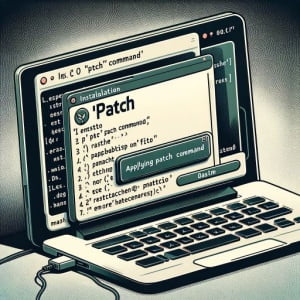Linux ‘patch’ Command | Installation and Usage Tutorial

Are you struggling with applying diff file patches to original files in Linux? For many, especially those new to Linux, this task can seem daunting. However, the ‘patch’ command is an invaluable tool that is definitely worth mastering. It’s readily available on most package management systems, which makes the installation process straightforward once you understand the steps.
In this guide, we will navigate you through the process of installing and using the ‘patch’ command in Linux. We will provide instructions for both APT and YUM-based distributions like Debian, Ubuntu, CentOS, and AlmaLinux. We will delve into more advanced topics such as compiling the ‘patch’ command from source and installing a specific version. Finally, we will guide you on how to use the ‘patch’ command and verify that the correct version is installed.
So, let’s dive in and begin installing the ‘patch’ command on your Linux system!
TL;DR: How Do I Install and Use the ‘patch’ Command in Linux?
The
'patch'command is typically pre-installed on most Linux distributions, you can verify this with,patch --version. However, if it’s not available, you can install it on Debian-based distributions like Ubuntu with the commandsudo apt-get install patch. For RPM-based distributions like CentOS, you can use the commandsudo yum install patch.
# For Debian-based distributions like Ubuntu
sudo apt-get install patch
# For RPM-based distributions like CentOS
sudo yum install patch
# Output:
# Reading package lists... Done
# Building dependency tree
# Reading state information... Done
# patch is already the newest version (2.7.6-6).
# 0 upgraded, 0 newly installed, 0 to remove and 0 not upgraded.
This command will check if the ‘patch’ command is already installed and if not, it will install it. The output message will indicate whether the ‘patch’ command was installed or if it was already the newest version.
This is just a basic way to install the ‘patch’ command in Linux, but there’s much more to learn about installing and using ‘patch’. Continue reading for more detailed information and advanced usage scenarios.
Table of Contents
- Understanding the ‘patch’ Command in Linux
- Installing ‘patch’ Command from Source Code
- Installing Different Versions of the ‘patch’ Command
- Basic Usage of the ‘patch’ Command
- Exploring Alternative Methods for Applying Patches
- Recommendations
- Troubleshooting Common Issues with ‘patch’ Command
- Tips for Using the ‘patch’ Command
- Understanding Patch Management in Linux
- Wrapping Up: Installing the ‘patch’ Command in Linux
Understanding the ‘patch’ Command in Linux
The ‘patch’ command in Linux is a powerful tool that is used to apply diff file patches to original files. It is an essential tool for developers and system administrators, as it allows them to quickly and efficiently update files with changes outlined in a ‘diff’ file. The ‘diff’ file is a text file that contains a list of differences between two files or sets of files. This is particularly useful when you want to apply multiple changes (patches) to a file without manually editing the file.
Now, let’s dive into how you can install this handy command in Linux.
Installing ‘patch’ Command Using APT
If you’re using a Debian-based distribution like Ubuntu, you can install the ‘patch’ command using the Advanced Packaging Tool (APT). Here’s how to do it:
sudo apt update
sudo apt install patch
# Output:
# Reading package lists... Done
# Building dependency tree
# Reading state information... Done
# patch is already the newest version (2.7.6-6).
# 0 upgraded, 0 newly installed, 0 to remove and 0 not upgraded.
The first command updates the package list on your system. The second command installs the ‘patch’ command. If it’s already installed, the system will let you know and won’t perform any unnecessary actions.
Installing ‘patch’ Command Using YUM
For RPM-based distributions like CentOS, you can use the Yellowdog Updater, Modified (YUM) to install the ‘patch’ command. Here’s how:
sudo yum check-update
sudo yum install patch
# Output:
# Loaded plugins: fastestmirror
# Loading mirror speeds from cached hostfile
# * base: mirror.its.dal.ca
# * extras: centos.mirror.iweb.com
# * updates: mirror.its.dal.ca
# patch.x86_64 0:2.7.1-12.el7
The first command checks for updates to the package list, and the second command installs the ‘patch’ command. If it’s already installed, the system will let you know.
Now that you know how to install the ‘patch’ command in Linux, you can start applying patches to files with ease. In the next sections, we’ll delve into more advanced uses of the ‘patch’ command, so stay tuned!
Installing ‘patch’ Command from Source Code
If you want to install the ‘patch’ command from the source code, you can download it directly from the GNU website. This method allows you to compile and install the latest version of the ‘patch’ command. Here’s how to do it:
wget http://ftp.gnu.org/gnu/patch/patch-2.7.6.tar.xz
# Output:
# --2022-04-22 00:00:00-- http://ftp.gnu.org/gnu/patch/patch-2.7.6.tar.xz
# Resolving ftp.gnu.org (ftp.gnu.org)... 209.51.188.20, 2001:470:142:3::b
# Connecting to ftp.gnu.org (ftp.gnu.org)|209.51.188.20|:80... connected.
# HTTP request sent, awaiting response... 200 OK
# Length: 723392 (706K) [application/x-tar]
# Saving to: ‘patch-2.7.6.tar.xz’
The above command downloads the ‘patch’ command source code from the GNU website. The output message indicates that the download was successful.
After downloading, you need to extract the tar.xz file, compile, and install it:
tar -xf patch-2.7.6.tar.xz
cd patch-2.7.6
./configure
make
sudo make install
# Output:
# patch is now installed in '/usr/local/bin'
This sequence of commands extracts the downloaded file, navigates into the extracted directory, configures the installation, compiles the source code, and installs the ‘patch’ command. The output message confirms the successful installation of the ‘patch’ command.
Installing Different Versions of the ‘patch’ Command
There might be situations where you need a specific version of the ‘patch’ command. This could be due to compatibility issues or the need for a specific feature available only in a certain version. In such cases, you can install a specific version of the ‘patch’ command either from source or using a package manager.
Installing Specific Version from Source
To install a specific version of the ‘patch’ command from source, you need to download the source code for that version from the GNU website. The process is similar to the one outlined above, but you need to replace ‘2.7.6’ with the version number you want to install.
Installing Specific Version Using APT or YUM
To install a specific version of the ‘patch’ command using a package manager, you can use the ‘apt-get’ or ‘yum’ command along with the version number. For instance, to install version 2.7.6 of the ‘patch’ command using APT, you would run:
sudo apt-get install patch=2.7.6-1
# Output:
# Reading package lists... Done
# Building dependency tree
# Reading state information... Done
# patch is already the newest version (2.7.6-1).
# 0 upgraded, 0 newly installed, 0 to remove and 0 not upgraded.
This command installs version 2.7.6-1 of the ‘patch’ command. The output message indicates whether the installation was successful or if this version is already installed.
Key Changes and Features in Different Versions
Different versions of the ‘patch’ command come with various changes and features. For instance, version 2.7 introduced the ‘–reject-format’ option, which allows you to specify the format of reject files. Version 2.7.6, on the other hand, provided several bug fixes and improvements over the previous versions.
Here’s a brief comparison of the different versions:
| Version | Key Features |
|---|---|
| 2.6 | Introduced ‘–binary’ option |
| 2.7 | Introduced ‘–reject-format’ option |
| 2.7.6 | Bug fixes and improvements |
Basic Usage of the ‘patch’ Command
Now that you have installed the ‘patch’ command, let’s look at how you can use it. The basic usage of the ‘patch’ command involves applying a patch file to an original file. Here’s an example:
patch < patchfile
# Output:
# patching file myfile
This command applies the changes outlined in ‘patchfile’ to the original file. The output message indicates that the file ‘myfile’ has been patched.
Verifying the Installation
To verify that the ‘patch’ command is installed correctly, you can use the ‘–version’ option. This command will display the version of the ‘patch’ command that is currently installed on your system:
patch --version
# Output:
# GNU patch 2.7.6
# Copyright (C) 2019 Free Software Foundation, Inc.
# License GPLv3+: GNU GPL version 3 or later <http://gnu.org/licenses/gpl.html>.
# This is free software: you are free to change and redistribute it.
# There is NO WARRANTY, to the extent permitted by law.
The output message displays the version of the ‘patch’ command that is currently installed on your system, confirming that the installation was successful.
Exploring Alternative Methods for Applying Patches
While the ‘patch’ command is an efficient way to apply patches in Linux, there are alternative methods that you might find useful depending on your specific needs. One such alternative is the ‘git apply’ command. This command is part of the Git version control system and is used to apply patches created with ‘git diff’ or even traditional diff files.
Applying Patches Using ‘git apply’
The ‘git apply’ command reads the supplied diff output and applies it to the current working directory. Here’s how to use it:
git apply patchfile
# Output:
# Changes applied successfully
The above command applies the changes outlined in ‘patchfile’ to the current working directory. The output message indicates that the changes were applied successfully.
Advantages and Disadvantages of Using ‘git apply’
The ‘git apply’ command offers several advantages over the traditional ‘patch’ command. For instance, it has a more robust syntax and can handle complex patches better. It also integrates seamlessly with the Git version control system, making it an excellent choice if you’re already using Git.
However, ‘git apply’ also has some disadvantages. It’s not as universally available as the ‘patch’ command, meaning you might not be able to use it on some systems. It also requires a working Git repository to function, which might not always be available.
Here’s a brief comparison of the ‘patch’ command and ‘git apply’:
| Method | Advantages | Disadvantages |
|---|---|---|
| ‘patch’ command | Universally available, Easy to use | Can’t handle complex patches |
| ‘git apply’ | Robust syntax, Integrates with Git | Requires Git repository, Not universally available |
Recommendations
If you’re working on a system that has Git installed and you’re comfortable with its syntax, ‘git apply’ can be a powerful alternative to the ‘patch’ command. However, if you’re working on a system without Git or prefer a simpler syntax, the ‘patch’ command is a reliable and efficient tool for applying patches.
Remember, the best tool for the job depends on your specific needs and circumstances. Both ‘patch’ and ‘git apply’ are excellent tools for applying patches in Linux, and understanding how to use both can make you a more versatile developer or system administrator.
Troubleshooting Common Issues with ‘patch’ Command
Like any tool, the ‘patch’ command can sometimes present challenges. Here, we’ll discuss common issues you may encounter when using the ‘patch’ command, along with their solutions and some useful tips.
Patch Fails to Apply
One common issue is the patch failing to apply. This can happen if the patch file and the original file have different line endings, or if the original file has been modified since the patch was created.
The solution is to ensure that the patch file and the original file have the same line endings, and that the original file matches the version that the patch was created from.
patch -p1 < patchfile
# Output:
# patching file myfile
# Hunk #1 FAILED at 1.
# 1 out of 1 hunk FAILED -- saving rejects to file myfile.rej
The output message indicates that the patch failed to apply. The ‘.rej’ file contains the parts of the patch that could not be applied.
Patch Command Not Found
Another common issue is the ‘patch’ command not being found. This can happen if the ‘patch’ command is not installed on your system, or if it’s not in your PATH.
The solution is to install the ‘patch’ command if it’s not installed, or to add it to your PATH if it’s not there.
patch --version
# Output:
# bash: patch: command not found
The output message indicates that the ‘patch’ command was not found. You can resolve this by installing the ‘patch’ command or adding it to your PATH.
‘patch’ Command Produces Unexpected Output
Sometimes, the ‘patch’ command may produce unexpected output. This can happen if the patch file is corrupt or if there’s a bug in the ‘patch’ command itself.
The solution is to check the integrity of the patch file and ensure that you’re using the latest version of the ‘patch’ command.
patch < patchfile
# Output:
# patch: **** Only garbage was found in the patch input.
The output message indicates that the patch file is corrupt. You can resolve this by obtaining a new copy of the patch file.
Tips for Using the ‘patch’ Command
Here are a few tips for using the ‘patch’ command effectively:
- Always check the integrity of your patch files before applying them.
- Keep your system updated to ensure that you’re using the latest version of the ‘patch’ command.
- Use the ‘–dry-run’ option to see what changes the ‘patch’ command will make without actually applying them.
By understanding these common issues and how to resolve them, you can use the ‘patch’ command more effectively and avoid potential pitfalls.
Understanding Patch Management in Linux
Patch management is a fundamental aspect of maintaining a secure and efficient Linux system. It involves the process of updating software applications with code changes, commonly referred to as ‘patches’, to improve functionality or fix security vulnerabilities. The ‘patch’ command is a critical tool in this process.
The Importance of Patch Management
Patch management is vital for several reasons. It helps to fix software bugs, improve system performance, and most importantly, address security vulnerabilities. Without regular patching, systems can become susceptible to attacks that exploit these vulnerabilities.
# Checking for available patches
sudo apt-get update
# Output:
# Hit:1 http://security.ubuntu.com/ubuntu bionic-security InRelease
# Get:2 http://archive.ubuntu.com/ubuntu bionic InRelease [242 kB]
# Get:3 http://archive.ubuntu.com/ubuntu bionic-updates InRelease [88.7 kB]
# Fetched 331 kB in 2s (162 kB/s)
In the above example, we use the sudo apt-get update command to check for available patches. The output shows that the system has fetched information about available updates from various repositories.
The Role of ‘patch’ Command in Patch Management
The ‘patch’ command in Linux plays a significant role in patch management. It allows system administrators and developers to apply ‘diff file patches’ to original files. A diff file contains a list of changes between two files or sets of files. These changes can be new features, bug fixes, or security updates. By applying these patches, you can update a file or set of files without having to replace them entirely.
# Applying a patch to a file
patch myfile < myfile.patch
# Output:
# patching file myfile
In this example, we apply a patch to a file named ‘myfile’ using the ‘patch’ command. The ” symbol indicates that the output of the ‘git diff’ command should be redirected to ‘myfile.patch’.
The Importance of Software Testing
Software testing is another crucial aspect of patch management. Before applying a patch, it’s important to test it to ensure it doesn’t introduce new issues. Automated testing tools can help streamline this process.
# Running a test suite after applying a patch
npm test
# Output:
# > jest
# PASS src/App.test.js
# App
# ✓ renders without crashing (25ms)
In this example, we run a test suite using npm (Node Package Manager) after applying a patch. The output shows that all tests have passed, indicating that the patch did not introduce any new issues.
Further Resources for Mastering Patch Management in Linux
If you’re interested in learning more about patch management in Linux, here are some resources that you might find useful:
- GNU Patch Manual: This is the official manual for the ‘patch’ command from GNU. It covers all the options and features of the ‘patch’ command.
Linux Patch Management: This book by Michael Jang provides a comprehensive guide to patch management in Linux.
The Linux System Administrator’s Guide: This online guide covers a wide range of topics related to Linux system administration, including patch management.
Wrapping Up: Installing the ‘patch’ Command in Linux
In this comprehensive guide, we’ve delved deep into the world of the ‘patch’ command in Linux, a powerful tool for applying diff file patches to original files. This command is an essential part of software development and system administration, particularly in the realm of patch management.
We started with the basics, learning how to install the ‘patch’ command in both Debian and RPM-based Linux distributions. We then dove into more advanced topics, such as using different options and flags, installing from source, and even installing specific versions of the ‘patch’ command.
Along the way, we tackled common issues that you might encounter when using the ‘patch’ command, such as failed patch applications and the ‘command not found’ error. We provided solutions to these problems, along with useful tips to ensure a smooth patching process.
We also explored alternative methods for applying patches, such as using the ‘git apply’ command. Here’s a quick comparison of these methods:
| Method | Pros | Cons |
|---|---|---|
| ‘patch’ command | Universally available, easy to use | May struggle with complex patches |
| ‘git apply’ | Robust syntax, integrates with Git | Requires Git repository, not universally available |
Whether you’re just starting out with the ‘patch’ command or you’re looking to level up your Linux skills, we hope this guide has given you a deeper understanding of the ‘patch’ command and its capabilities.
With its balance of simplicity and power, the ‘patch’ command is a vital tool for any Linux user. As you continue to explore and master Linux, this command will undoubtedly serve you well. Happy patching!


